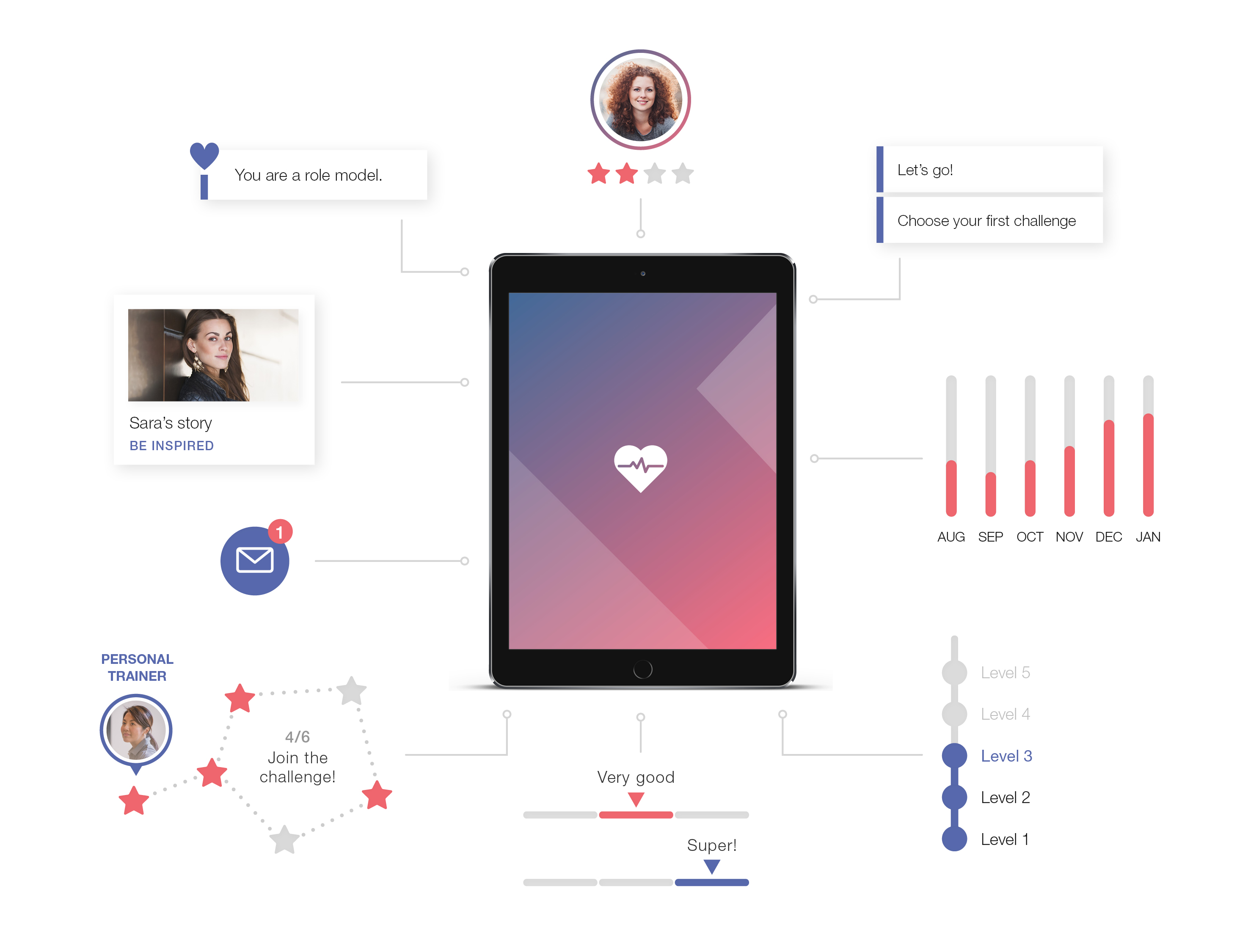There is no doubt that the last 18 months brought the subject of health and well-being into sharp focus. Many of us had to learn how to stay active within the four walls of home, devoting significant willpower, determination, and energy into ensuring that the sudden lack of activity and routine didn’t come at the expense of our health.
It is of course true that most of us know that we need to eat well and exercise regularly to stay healthy. Nevertheless, it is also the case that a lot of us find it hard to do either in a sustained manner. Rationally, we may know these things are important for our own personal interest, but something often seems to get in the way. Academics, behavioural experts, and health professionals have known for many years that mere awareness of a health issue or risk is not always enough to motivate people to change deeply entrenched habits or to develop new ones.
Developing and sustaining motivation for lifestyle change is critical in managing chronic conditions such as cancer, diabetes or heart and pulmonary disease. But the same is equally true across many other aspects of healthcare as well as any number of personal health and fitness related goals, be it remembering to take medication at particular times, kicking bad habits, the journey from couch to 5k, or any number of well-intentioned New Year’s Resolutions.
Health motivation has many of the same influences as other aspects of motivation but with, perhaps, some specific additions to the mix. Alongside the obvious environmental, physical, and psychological variables and the experiences that can shape our perceptions, there is an equation of perceived susceptibility, perceived severity, perceived benefits, and perceived barriers that can combine to determine individual attitudes and actions. Even with a positive attitude, action can often still require a cue, stimulus, or nudge. We all need encouragement to put us, and keep us, on the right path and that is where the use of digital innovation can go a long way to building our engagement.
More than ‘just a game’
Gamification, Serious Games and Game Design have all been growing in use over the last 10 years in a wide range of non-entertainment contexts, from finances to learning to play the piano and everything in between. There are several reasons for this, a key one being how well these approaches can engage and focus users. It is this capacity for engagement, encouragement and commitment that can make Game Design and Gamification significantly impactful within Health and Wellbeing.
Want to refresh your memory on Gamification?
Check out our explainer on Serious Games, Game Design,
and the use of Gamification following the link below.
Recent years have seen an increased application of game thinking across health, fitness, and wellbeing through the explosion of fitness apps and a better understanding of motivation and behavioural psychology. The growing use of Gamification to support the management of chronic illness, rehabilitation, health, and wellbeing is already proving to have fascinating and significant benefits. Serious contexts with serious connotations and consequences, but with an opportunity to inject well designed user focussed strategies that can support people on their journey to changing their behaviours for the better and towards improved health.
A System for Support
An important initial step in managing a long-term condition, such as diabetes or a heart condition, is helping with their overall understanding and awareness. Depending on diagnosis, traditionally a GP or doctor will talk through symptoms to monitor or watch out for supported with leaflets, websites and an initial schedule of check-ups and tests. In cases where the individual may have access to specialists and dedicated practitioners, their progress and the management of their condition may have more support to hand – perhaps with these specialists available for frequent check-ups and monitoring, personalised health plans, etc. Sadly, the growing prevalence of these conditions across a health service that is already economically challenged, makes this support increasingly difficult to provide.
Despite the best endeavours of healthcare professionals, diagnosis of a chronic illness can still be a lonely, confusing, or frightening period for many. Faced with such, it is all too easy to resort to the internet to identify and interpret symptoms or browse forums to find what has worked for other people. This can, of course, become even more confusing and frightening since the available information may not feel relevant or be appropriate for each situation.
Given the importance of scalability and availability, this is where appropriate and well-designed technology solutions can help to complement the support system provided by medical professionals facing a level of increasing demand that they cannot possibly satisfy in the long term. Whilst some people have claimed that the pace of digital innovation that has taken place in the last ten months is equivalent to that of the previous ten years, this does not perhaps fairly reflect some of the innovation that has been quietly taking place across the health sector and is starting to deliver significant benefits.
Health and Gamification in Practice
A good example of gamification being successfully integrated into a healthcare solution can be seen with PainSquad: a smartphone based electronic pain management tool which helps 8 to 18-year old cancer patients track pain levels and complete daily reports. It turns an emotionally complex task into an engaging experience, as users climb the ranks and earn rewards by habitually using a crime-fighting style application. The result? 90%+ initial completion rates for the pain journals, a percentage noted to be unheard of in paediatric medicine, highlighting the empowering and constructive impact that a gamified experience can have.
Another example of using gamification can be seen with Mango Health. Their smartphone application is designed to allow users to set up their daily medication schedule and then provides them with appropriate prompts to take the medication. If the user takes their medication at the right time, they earn points that can be converted into gift cards or even charitable donations. On top of this, the mobile app also provides educational materials about the user’s medication, including drug interactions and potential side effects.
Occasionally there is a concern raised regarding the opportunity to address health matters with digital solutions, based on an assumption that it involves expensive and frequently inaccessible technologies. Or that they end up reducing the important subject and science at their core. However there are plenty of examples where technology has helped make a significant and positive impact on health and well being, and plenty of examples demonstrating how technology actually improves scalability and accessibility of much needed support. For instance, the role of virtual reality video games in promoting active movement, improving balance, and increasing energy expenditure in children with cerebral palsy. These examples have used a Nintendo Wii or Microsoft Kinect as a low cost, accessible way to offer self-motivated physical therapy through a video game. Studies showed that patients who participated in virtual reality gaming therapy increased the intensity, frequency, and duration of therapy movements, leading to enhanced motor performance.
Whilst the use of gamification in healthcare has been around for a while, it is still developing and continues to represent a significant opportunity for future research and impact. As an example that demonstrates how fast this is expanding and how seriously it is being applied right now, the FDA in America recently made a landmark decision to officially validate the use of a video game as a prescribed treatment for children with ADHD after 7 years of clinical trials.
Rehabilitation and Recovery
Another stimulating opportunity area for the application of game thinking in healthcare lies in rehabilitation and recovery from acute conditions such as strokes or spinal injury. Here, there are good examples where “real” games can play as important a role in a patient’s recovery as specifically made serious games. To help recovery, the engaging and fun nature of the game is of critical importance. Video games require focused and repetitive movements, which is often exactly what is needed for this kind of rehabilitation. Because the game is fun and provides the patient a distraction whilst they play, it is potentially able to offer a degree of sustainability that traditional rehabilitation may not always be able to easily provide.
For example, games such as Battlefield have been used to help stroke patients by using special controllers that use the feet rather than hands to move. This has been shown to help to recover lost function, by encouraging repetitive movements and stimulation. Research has also shown that more active games, such as Wii Fit Sports, where controllers are motion activated, can improve upper body muscle activation in quadriplegics and tetraplegics.
In contrast to the reuse of standard games with modified controllers or gameplay tweaks, there are also games that are created specifically for rehabilitation. One such game, designed by a research team at Newcastle University, was successfully used to evaluate the effectiveness of small changes to therapeutic regimes, by asking the patient to play a simple video game that measured their physical responses to onscreen movement.
One of the key reasons we are all drawn to games in their different forms is precisely because of their ability to immerse us in a different world, or a different story, with different rules to the one we live in normally. The notion of being able to open new worlds for people to explore, when they may be feeling trapped or struggling in whatever way, is incredibly exciting and is matched with the positive results and outcomes achieved in patients taking on these new forms of therapy. In the same way that we are seeing more and more innovative story telling in the traditional world of games, perhaps we can look forward to even more inspirational blends of imagination, creativity and science to deliver real change and impact in rehabilitation and recovery?
Wellbeing
Wellbeing is often used to cover a vast array of topics, from mental wellness to weight management to fitness. Whether it is the use of Wii Bowling to help keep the eldering active, corporate fitness schemes that make use of wearable technologies to create internal competitions and challenges or more bespoke solutions that help monitor mental health and depression such as SuperBetter, game thinking and gamification are increasingly being applied to enable effective solutions.
Within the workplace, gamified solutions have already proven the value and positive impact they can offer in terms of the employee experience and in achieving organisational objectives. Whether it is in terms of consistent and effective onboarding, uniting remote teams, engaging individuals in learning and development, or standardising processes and approaches, gamified tools and experiences have been shown to be readily adopted and to deliver tangible results. However, there is space for this value and user centric approach to be directed towards corporate wellness schemes in order to produce meaningful solutions, beyond counting how many daily steps you achieve as a team. There is no doubt that the world of work already has and will continue to undergo significant change. There is already acute focus on employee wellbeing and organisations across all sectors are faced with the need to increase participation, commitment and overall engagement amongst their employees whilst also finding the balance between empathy and effectiveness. During the pandemic, the necessary distancing, shielding, and lockdown requirements meant that loneliness impacted on health and wellbeing with 24% of adults feeling significantly isolated. The use of technology to replace face to face social interactions undoubtedly helped some individuals maintain contact and activities through these abnormal times. There has never been a more important time for organisations to apply innovation to these areas with digital solutions to support health and well-being as an intrinsic part of their employee experience.
Change for the Future
There is enough pressure in today’s society to fit one fitness standard or another, and the reality is everyone is fighting their own personal challenge regarding their health and wellbeing and where they would like it to be. Whatever the solution, it cannot lose sight of the end needs and requirements of the user it should be helping and supporting. Solutions do not need to be overly complex to be effective. When considering behaviour change, we are often focused on making small changes to help new behaviours stick. Constant availability, reliability and security are also important characteristics of these solutions whilst it is important to keep in mind that there is no “one size fits all” approach so personalisation and user-focussed design will determine adoption and ultimately sustained behaviour outcomes. It is time to take careful steps towards future designs that leverage the exciting possibilities and mechanics, founded on the exciting scientific research, in order to deliver exciting and encouraging results for the individuals at the heart.



